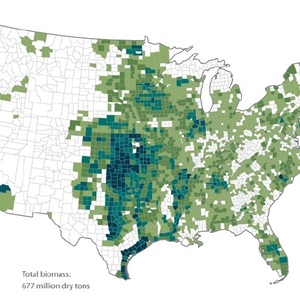UCS: 680 million tons of U.S. biomass available by 2030




Union of Concerned Scientists, “The Promise of Biomass"
October 12, 2012
BY Erin Krueger
The Union of Concerned Scientists has published a report that shows that biomass feedstock has the potential to dramatically increase our nation’s renewable energy supply. The report, titled “The Promise of Biomass,” determined that 680 million tons of biomass could be made available by 2030. That biomass, which could be used to produce fuels and power, is enough to produce 54 billion gallons of cellulosic biofuel, or to generate enough electricity to meet one-fifth of nationwide demand.
In the study, the UCS noted that the key to using biomass resources in a beneficial way is to focus on the right resources, and to use them at an appropriate scale. The organization also said that bioenergy has the potential to grow rapidly. “The fact that it can be produced from a variety of resources distributed around the country represents a significant opportunity for local and regional economies,” said the UCS in the study. “Developing the technologies, practices, and policies needed to use these resources responsibly, while avoiding the pitfalls associated with unsustainable development, will ensure that communities across America benefit both financially and environmentally.”
Advertisement
Advertisement
The report provides detailed maps with regard to different biomass sources that describe where the UCS expects certain types of feedstocks to be abundant. The study addresses energy crops, agricultural residues, waste materials, and forest biomass.
According to the study, the largest long-term opportunity to expand bioenergy production in the U.S. is from dedicated energy crops, such as switchgrass and miscanthus, as well as fast-growing trees like hybrid poplar and willow. The UCS said as much as 400 million tons of these crops could be produced on an annual basis by 2030. The organization estimates that an additional 155 million tons of biomass could be sourced from agricultural residues. Waste materials, including household garbage, vegetative waste and construction and demolition debris, along with manure and other livestock related waste could be a source for approximately 101 million tons of biomass. Finally, forest waste, including tree tops and limbs, could generate 20 million tons of biomass.
Advertisement
Advertisement
“We see major potential for clean power and fuel from these renewable resources,” said Jeremy Martin, a senior scientist at UCS and author of the report. “But it is important to focus on the right kinds of resources, and the scale at which they can be utilized that balances energy and environmental needs.”
“The scale of the biomass resources available to us in this country shows that we can produce biofuels in a way that doesn’t pit the fuel we put in our cars against the food we consume,” Martin continued. “Biomass gives our nation the opportunity it needs to create a long and sustainable future for biofuels.”
Related Stories
The U.S. Department of Energy Bioenergy Technologies Office (BETO) announced up to $23 million in funding to support research and development (R&D) of domestic chemicals and fuels from biomass and waste resources.
The U.S. DOE has announced its intent to issue funding to support high-impact research and development (R&D) projects in two priority areas: sustainable propane and renewable chemicals and algal system cultivation and preprocessing.
Sens. Sherrod Brown, D-Ohio, and Pete Ricketts, R-Neb., in August introduced the Renewable Chemicals Act, a bill that aims to create a tax credit to support the production of biobased chemicals.
The Chemical Catalysis for Bioenergy Consortium, a consortium of the U.S. DOE’s Bioenergy Technologies Office, has launched an effort that aims to gather community input on the development of new biomass processing facilities.
USDA on March 8 celebrated the second annual National Biobased Products Day, a celebration to raise public awareness of biobased products, their benefits and their contributions to the U.S. economy and rural communities.
Upcoming Events










